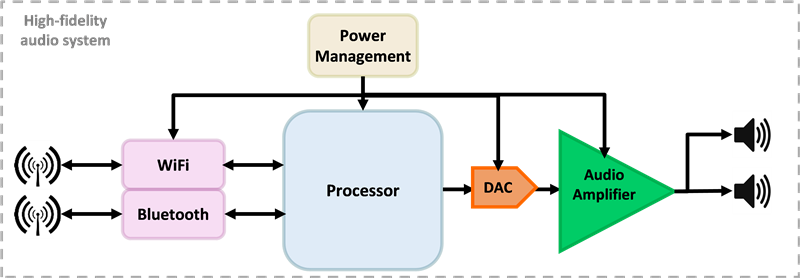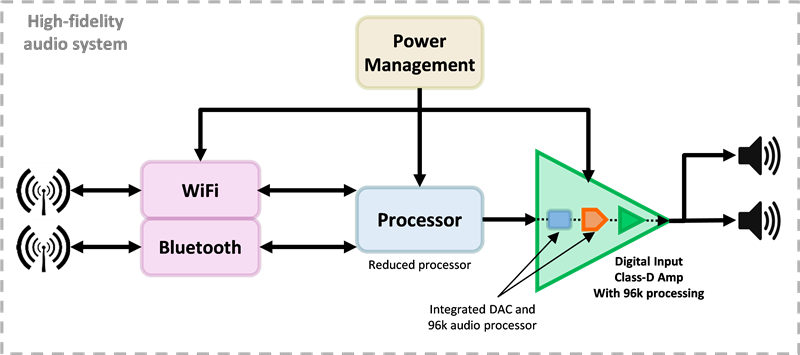SSZTA48 June 2017 TAS5782M
Audio system designers, responding to customer demand for top audio quality, are looking into high-resolution (hi-res) or high-definition (HD) audio as more and more mid-tier system buyers demand the type of HD audio performance that was previously available only in high-end systems. In the past, a 44.1kHz CD-quality sampling frequency may have been sufficient for much of the market, but today (and for the foreseeable future), high-fidelity sound will only continue to increase in popularity.
According to professional and consumer audio equipment companies, a higher sampling frequency captures and reproduces a much wider frequency range. The reproduction of audio frequencies greater than 20kHz, including ultra-high-frequency harmonics, gives the subtle components of a sound (especially acoustic instruments) their character. According to these audio equipment companies, there are technical merits that make it worth moving toward higher sampling frequencies, such as minimizing unwanted side effects due to the steep filters employed during digital-to-analog or analog-to-digital conversion.
Simply picking an off-the-shelf music player will not deliver the promise of hi-res audio, which requires dedicated hardware to really enjoy its richness and subtleties. Of course, not every audio file or medium is recorded in HD audio either.
Designing an HD Audio System
As with every high-performance design, taking a systemwide approach to the entire audio signal chain ensures a robust and high-performance solution. Because each link in an audio signal chain is important, it is only as strong as its weakest link; each and every link must be capable of meeting all design target specifications, such as performance, cost, time to market and ease of use. Figure 1 shows the basic blocks inside an HD system.
 Figure 1 HD Audio System
Figure 1 HD Audio SystemThe power-management block provides the right power levels to the Wi-Fi® speaker circuitry. Assuming a system-powered application (not battery-operated) and depending on the output power, the power supply not only needs to deliver the voltage and current required to match the system’s power requirements; it also needs to provide a clean and stable power rail to prevent any power noise from entering the audio system and degrading the audio quality.
The connectivity block provides wireless communication to the system using Wi-Fi or Bluetooth® from a computer, smartphone, tablet or wireless-enabled product. Standard Bluetooth modules today offer complete solutions for portable audio systems, as they support wireless and wired-in audio natively. But their limited bandwidth poses a potential bottleneck given the higher bandwidths that lossless hi-res audio streams require. New Bluetooth audio-coding technologies promise to increase the bandwidth to support HD audio.
Wi-Fi, on the other hand, includes greater network capacity, robust signaling and an extended radio-frequency range over alternative short-range wireless technologies. Its increased bandwidth capacity and system throughput make it more suitable for HD audio applications.
The processor executes various audio processing functions like decoding and signal equalization while also processing the Wi-Fi and/or Bluetooth communications software stacks. In the past, a CD-quality sampling frequency may have been sufficient. But today’s high-fidelity audio systems place additional demands on the processor in the signal chain, as high-fidelity sound-quality requirements grow to provide sampling rates in the range of 48kHz to 192kHz on a 24-bit music signal stream.
The audio block contains all of the electronics necessary to drive the speakers in the system. Because the signal coming from the connectivity block and processor have both low-voltage and low-current capabilities, an audio amplifier provides the signal with the necessary higher voltage and current capabilities to drive the drivers in the speaker system. This block may include an audio digital-to-analog converter (DAC) to convert the digital audio signal from the processor to analog, and to provide additional audio processing in the digital domain to further enrich the customer experience in higher-end systems. Another key component of the audio block is the audio amplifier.
Audio Amplifiers: Class-AB vs. Class-D
You have two choices when selecting the best audio amplifier for your HD audio systems: Class-AB or Class-D. Class-AB audio amplifiers are linear amplifiers that do not require many external electronic components. But they are highly inefficient and require substantial passive or even active thermal management in the form of heat sinks and fans.
On the other hand, Class-D audio amplifiers are highly efficient switching amplifiers that need very little thermal management, but they do require output inductors.
For years, the amplifier of choice in HD audio was a Class-AB amplifier. Audio Class-D amplifiers were considered substandard because they didn’t meet all of the requirements for HD audio; not anymore. TI’s latest generation of Class-D amplifiers boost the overall performance and efficiency of HD audio systems by creating a symbiotic relationship with the digital engine while efficiently transferring enhanced audio quality to the speakers.
Optimizing HD Audio Design
High-performance HD audio amplifiers with an integrated DAC and processing, like TI’s new TAS5782M, can help audio designers greatly simplify their designs, reduce costs and shorten design cycles. The integrated DAC helps reduce system complexity by providing a way to connect the audio amplifier directly to the processor, ensuring maximum signal integrity and reduced component count.
Integrated audio processing can greatly help reduce the cost and computational requirements of the main applications processor by offloading all of the audio processing into the amplifier itself. You can further reduce cost and size by reducing the cost and size of the main processor. Figure 2 is an optimized block diagram.
 Figure 2 Optimized HD Audio System
Figure 2 Optimized HD Audio SystemHave you designed an HD audio system? If so, what specifications were most important to you? Log in and leave a comment below, or visit the TI E2E™ Community Audio Amplifiers forum.
Additional Resources
- Start designing an HD audio system quickly with the TAS5782M evaluation module.
- Check out TI.com/audio to browse the entire audio portfolio.
- Read the application note, “TAS5782M Process Flows,” which shows how the TAS5782M’s easy-to-use hybrid flows can help you simplify your design cycle time.
- Watch this video to learn more about the TAS5782M Class-D amplifier.